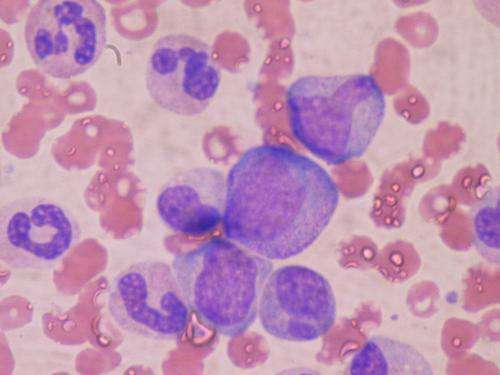This article has been reviewed according to Science X's editorial process and policies. Editors have highlighted the following attributes while ensuring the content's credibility:
fact-checked
trusted source
proofread
Possible explanation for long-term effects in leukemia survivors discovered

Contrary to previous beliefs, stem cells, from which all new blood cells are formed, remain in bone marrow in the blood cancer type acute lymphocytic leukemia. This disease, however, causes a hidden defect in the stem cells that, over time, makes them lose their ability to form new blood cells. These findings, by researchers at Linköping University in Sweden, may be part of the explanation for why leukemia survivors experience negative effects on blood formation decades later.
"It's estimated that a normal person produces so many blood cells in a lifetime that these could fill a large passenger aircraft. As many of the cells in our blood have a short life span in our bloodstream, new blood cells are constantly formed so that we can stay healthy," says Mikael Sigvardsson, professor in the Department of Biomedical and Clinical Sciences (BKV) at Linköping University and professor in the Division of Molecular Hematology at Lund University.
All types of blood cells are formed from blood stem cells found in bone marrow in the skeleton. In normal blood formation, new cells are formed in a multi-stage maturation process. But sometimes things go wrong. Mikael Sigvardsson studies a type of blood cancer called B-cell acute lymphoblastic leukemia, B-ALL.
In B-ALL, a B cell, which normally produces antibodies, has stalled at an intermediate stage in its development, resulting in uncontrolled cell division. The more cancer cells that are formed, the tighter the limited space inside the bone marrow becomes, and normal blood formation is progressively disrupted.
This results in a lack of oxygen-transporting red blood cells, which is also known as anemia. Other symptoms include an increased risk of infection when immune cells deteriorate, and bruises and bleeding when the lack of blood platelets reduces the blood's ability to clot.
The prevailing opinion is that reduced blood formation in leukemia may be due to cancer cells forcing blood stem cells out of the bone marrow. But in their recent study, published in Haematologica, the Linköping University researchers show that this is incorrect.
"We saw that the blood stem cells were still in the bone marrow. This could explain why good blood formation is quite quickly restored in a significant share of B-ALL patients once treatment has started and the number of cancer cells has been reduced. But the various intermediate stages in blood formation disappeared," says Mikael Sigvardsson.
The researchers studied cells from the bone marrow of mice developing B-ALL as a result of mutations in two leukemia-related genes. This animal model, developed by Mikael Sigvardsson's group, corresponds well to the disease in humans. As different blood cells have different protein combinations on the cell surface, researchers can take advantage of this to sort and count them.
By conducting analyses at various time points during the course of the disease, the researchers were able to find out which cell types were the first and the last to disappear. The researchers also analyzed cells from the bone marrow of 19 B-ALL patients and obtained corresponding results. The number of blood stem cells remained the same also in advanced stages of the disease.
Many B-ALL survivors experience blood cell function disorders later in their lives. This causes immune system flaws and increases the risk of new cancer diagnosis. In some leukemia survivors, it is possible to see that a small number of blood stem cells "take over," so that all blood cells in the body originate from a very small number of stem cells—in extreme cases from one cell only. This is most often due to these blood stem cells having DNA mutations that make them grow better than other cells. Such mutations may have been caused by chemotherapy used to treat the original leukemia and may constitute a first stage in developing a new cancer.
But the current study indicates that leukemia in itself seems to cause defects in blood stem cells. The researchers transplanted blood stem cells from the mice with leukemia to healthy mice. It turned out that, at the outset, these blood stem cells functioned well. But several months later, they started disappearing from the bone marrow and could no longer form new blood in the healthy mice.
"It seems that the remaining stem cells have a functional damage that can't be seen until long afterwards. We think that this could explain some of the long-term effects seen in certain adults having survived childhood cancer," says Mikael Sigvardsson.
According to Mikael Sigvardsson, such effects on the blood stem cells may come to be more obvious in the future if classic chemotherapy treatment is replaced with targeted treatment that is less toxic to normal cells.
More information: Christina T Jensen et al, B-lineage acute lymphoblastic leukemia causes cell autonomous defects in long-term hematopoietic stem cell function., Haematologica (2023). DOI: 10.3324/haematol.2022.282430




















